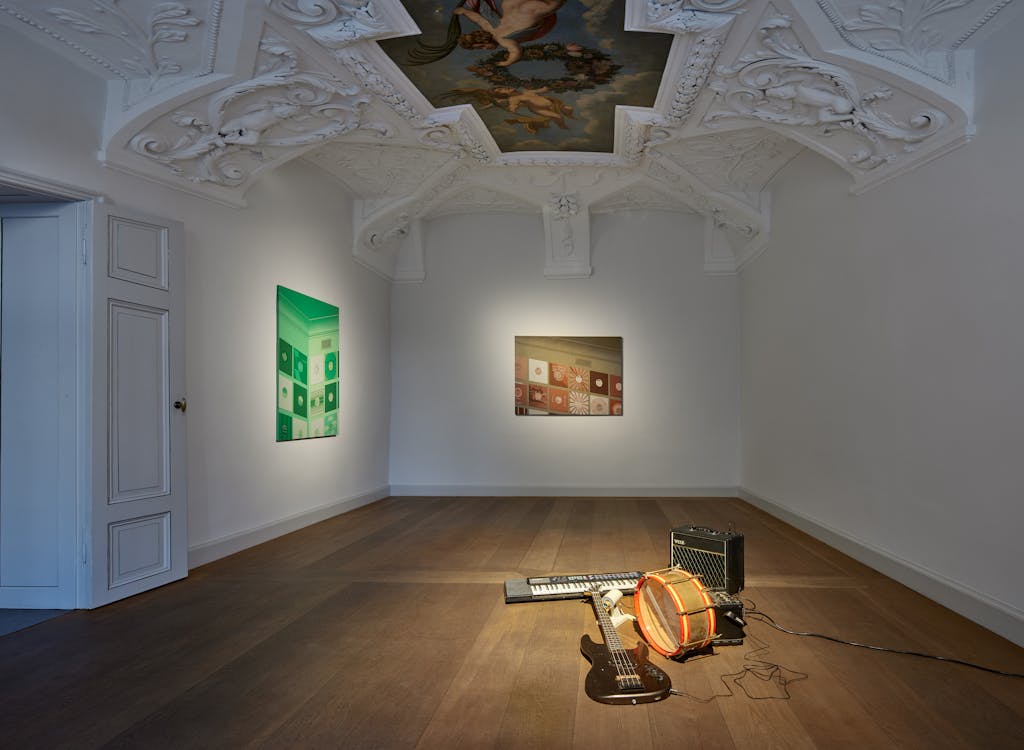Israeli Naama Tsabar involves viewers with her interactive installations, Works on Felt (2019 and 2021), which combine elements of sculpture, music, form, and sound. Visitors are thus invited to use the objects as musical instruments, plucking the strings and playing the sounding body of felt. Dirk Bell leads visitors through his multilayered installation with the no less complex title ODEMembran REMEMBeRAN (INTIM.E WEME.ET NOW,HERE) (2007/22) of fragile drawings and objects on a playful journey to word games with references to literature and music. Sergei Rostropovich makes us witness the Yanshui Beehive Fireworks Festival in Taiwan in his visually and sonically powerful video installation When the Lights Go Out (2006, music by Konrad Black). By editing the footage, the traditional procession, accompanied by a plethora of fireworks, is distorted into a dramatic performance and removed from any reality of life, a spectacle amid flashes of light and booming sound.
The way Rebecca Horn's kinetic sculpture, Zimbel Zen (2006), behaves is comparatively restrained; it can hardly be expected or predicted. On the construction on the wall, a large seashell spins as if listening around the gallery. After it pauses, two small cymbals bump against each other and, like a sudden discharge, produce a bright, clear, an almost pure sound that resonates for a long time. From a different place, however, a sound of a completely dissimilar quality appears: electric guitar, drum, and keyboard are arranged in the floor sculpture The Missing Musician (2022) by Marcelo Viquez in such a way that, starting from a converted table fan, each instrument plays the other: Through touch, pressure, and sound, a permanent, at times pulsating sound is created in an incessant circular orchestra, similar to a perpetuum mobile that seemingly no longer needs the musician.
At a central point of the exhibition, Markus Lüpertz's painted sculpture Mozart (2003-04) can be seen. The small work, a statue in classical contrapost, but seemingly incomplete in the execution of its limbs, remains in the tension field between completion and fragment. The depiction shows characteristics of the composer, yet it is neither a portrait of Mozart nor an allegory; it is a homage to his genius and virtuosity.
Threaded Together by Memory Sounds (2022) by Indian artist Astha Butail is a work that very quietly integrates itself into the ensemble of this exhibition. A series of wooden flutes that were never usable as such, threaded in two frames, refer, as the title suggests, to memory. Here, the transmission of memories, of legends and myths through different cultural techniques, is thematised, also through music, which is heard here purely visually. A visualisation of one of her breaths by the Korean artist Kimsooja can be seen here as a digital embroidery. One Breath (2004/16) shows in its pictorial reduction the sound curve of this essential function, which allows for a multitude of connotations, cultural and very personal references. A silence also emanates from Johanna Dumet's painting Le château impossible (2022): a house of cards whose stability is missing crucial elements. This silence is under tension; through her quick, almost fleeting brushstroke, the French artist marks the ephemeral, soundless fragility of the construction – on the verge of collapse.
The monumental painting Blue Note (2016) by Sean Scully draws its drama not least from its dimensions and its presence in the gallery space. Beyond that, however, the seemingly reductive abstraction of the works by the Irish-American painter and sculptor encompasses a whole range of evoked perceptions, from the power of colour to the depicted quality of light. Hendrik Krawen represents a different painterly position with two of his Porträts (1999 and 2001). The portraits are not of humans, however, but of record sleeves hanging closely together on walls, sections of rooms as if they had been quickly snapped, but painted accurately and in detail in oil, but so alienated in colour that they are ostentatiously removed from any realism. Don Van Vliet, who redefined the boundaries of rock music in his musical career as Captain Beefheart, later devoted himself to painting and was also held in high esteem here, shows an expressive painting of great improvisational freedom in his painting Cats Got His Tail (1985).
The selection of artists and works reflects diverse cultural backgrounds and forms of expression. And this is what makes the selected works in Paracusia: Remix so special: they are able to confront us as active participants in a shared orchestration, even if not all of the works produce sounds on their own. The works respond to each other: by themselves, through the spatial context of their neighbourhood, through the connections that gallery visitors make through their perceptual experiences and carry through the rooms.
The artists of the exhibition Paracusia: Remix:
Dirk Bell, born 1969 in Munich, lives in Berlin.
Astha Butail, born in Amritsar, India, lives in Guagon, India.
Johanna Dumet, born 1991 in Guéret, France, lives in Berlin.
Rebecca Horn, born 1944 in Michelstadt, Germany, lives in Berlin and Paris.
Kimsooja, born 1957 in Daegu, South Korea, lives in South Korea and New York.
Hendrik Krawen, born 1963 in Lübeck, Germany, lives in Berlin.
Sergei Rostropovich, born 1986 in New York, lives in Paris and Berlin.
Sean Scully, born 1945 in Dublin, lives in Bavaria and in New York.
Naama Tsabar, born 1982 in Tel Aviv, Israel, lives in New York.
Don Van Vliet, born 1941 in Glendale, CA, died 2010 in Arcata, CA, USA.
Marcelo Viquez, born 1971 in Montevideo, lives in Mallorca.
